Flood Exposure Assessment and Mapping: A Case Study for Australia’s Hawkesbury-Nepean Catchment
Abstract
1. Introduction
1.1. Floods as a Natural Hazard
1.2. Research Aims and Objectives
2. Materials and Methods
2.1. Study Area
2.2. Flood Exposure Indicators
2.2.1. Population Density
2.2.2. Land Use Type
2.2.3. Critical Infrastructure Density
2.3. Data
2.3.1. Population Density
2.3.2. Land Use Type
2.3.3. Critical Infrastructure Density
2.4. Index Calculation and Mapping
3. Results
4. Discussion
4.1. Population Exposure
4.1.1. Population Exposure Patterns
4.1.2. Population Density Indicator Analysis
4.2. Land Use Exposure
4.2.1. Land Use Exposure Patterns
4.2.2. Land Use Type Indicator Analysis
4.3. Critical Infrastructure Exposure
4.3.1. Critical Infrastructure Exposure Patterns
4.3.2. Critical Infrastructure Density Indicator Analysis
4.4. Flood Exposure Index
5. Conclusions
Author Contributions
Funding
Data Availability Statement
Acknowledgments
Conflicts of Interest
Appendix A
| Source | Definition |
|---|---|
| United Nations International Strategy for Disaster Reduction (2009) | The people, property, systems, or other elements present in hazard zones that are thereby subject to potential losses. |
| Kundzewicz and Stoffel (2016) | The assets and populations at risk; the presence of people, livelihoods, or ecosystems… in places and settings that could be adversely affected by floods. |
| Nasiri et al. (2016) | People and their surroundings and every element present in flood-prone area being exposed to the flood impacts as a subject to potential losses. |
| United Nations Office for Disaster Risk Reduction (2020) | The assets of interest and at risk (such as the environment, the economy, buildings, or people); the situation of… tangible human assets located in hazard-prone areas. |
| Membele et al. (2022) | The probability that people or physical items will be impacted by floods. |
| Ming et al. (2022) | At-risk elements such the types, characters, and values of the properties or buildings that are under threats of flooding. |
| IPCC (2022) | The presence of people; livelihoods; services and resources; infrastructure; or economic, social, or cultural assets in places and settings that could be adversely affected by a flood event. |
Appendix B
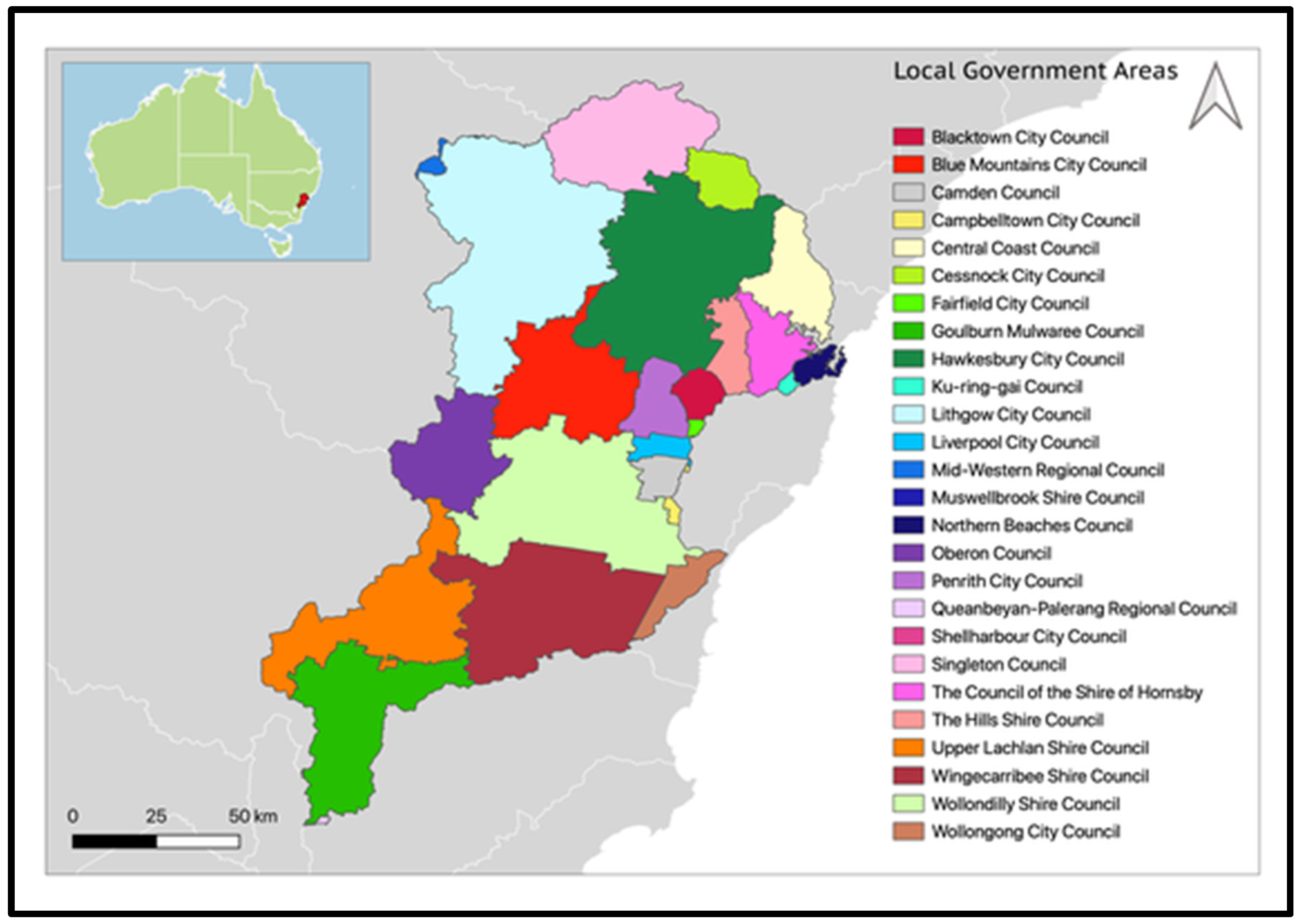
Appendix C
Appendix D
| Indicator/ Sub-Indicator | Dataset | Source | Original Resolution | Year |
|---|---|---|---|---|
| Population density | Regional population estimate | ABS | SA2 polygon vector | 2021 |
| Land use type | NSW Landuse 2017 v1.2 | NSW Government | 50 m raster | 2017 |
| Roads | GEODATA TOPO 250K Series 3 | Geoscience Australia | 50 m polyline | 2006 |
| Power stations | Foundation Electricity Infrastructure | Geoscience Australia | 50 m point | 2021 |
| Power substations | Foundation Electricity Infrastructure | Geoscience Australia | 50 m point | 2021 |
| Electricity transmission lines | Foundation Electricity Infrastructure | Geoscience Australia | 50 m polyline | 2021 |
| Hospitals | MyHospitals database | Australian Government AIHW | 50 m point | 2022 |
| Police stations * | ArcGIS Online | ArcGIS Online | 50 m point | 2021 |
| SES offices * | ArcGIS Online | ArcGIS Online | 50 m point | 2019 |
| Broadcast transmission towers | Broadcast Transmitter Data (AM Radio, FM Radio, Digital TV, Digital Radio, and current and future temporary transmitters) | Australian Government ACMA | 50 m point | 2017 |
Appendix E
Other
| Forestry
|
Appendix F
Appendix F.1. Other, Water Bodies (0.1)
Appendix F.2. Nature Conservation, Forestry (0.5)
Appendix F.3. Cropping, Grazing, Horticulture (0.7)
Appendix F.4. Infrastructure (0.9)
Appendix G
| Indicator | Fuzzy Midpoint | Fuzzy Spread |
|---|---|---|
| Population density | 500 people/km2 | 2 |
| Land use type | 50 (integer value) | 5 |
| Critical infrastructure density | 0.2 (0–1 normalised) | 2 |
Appendix H
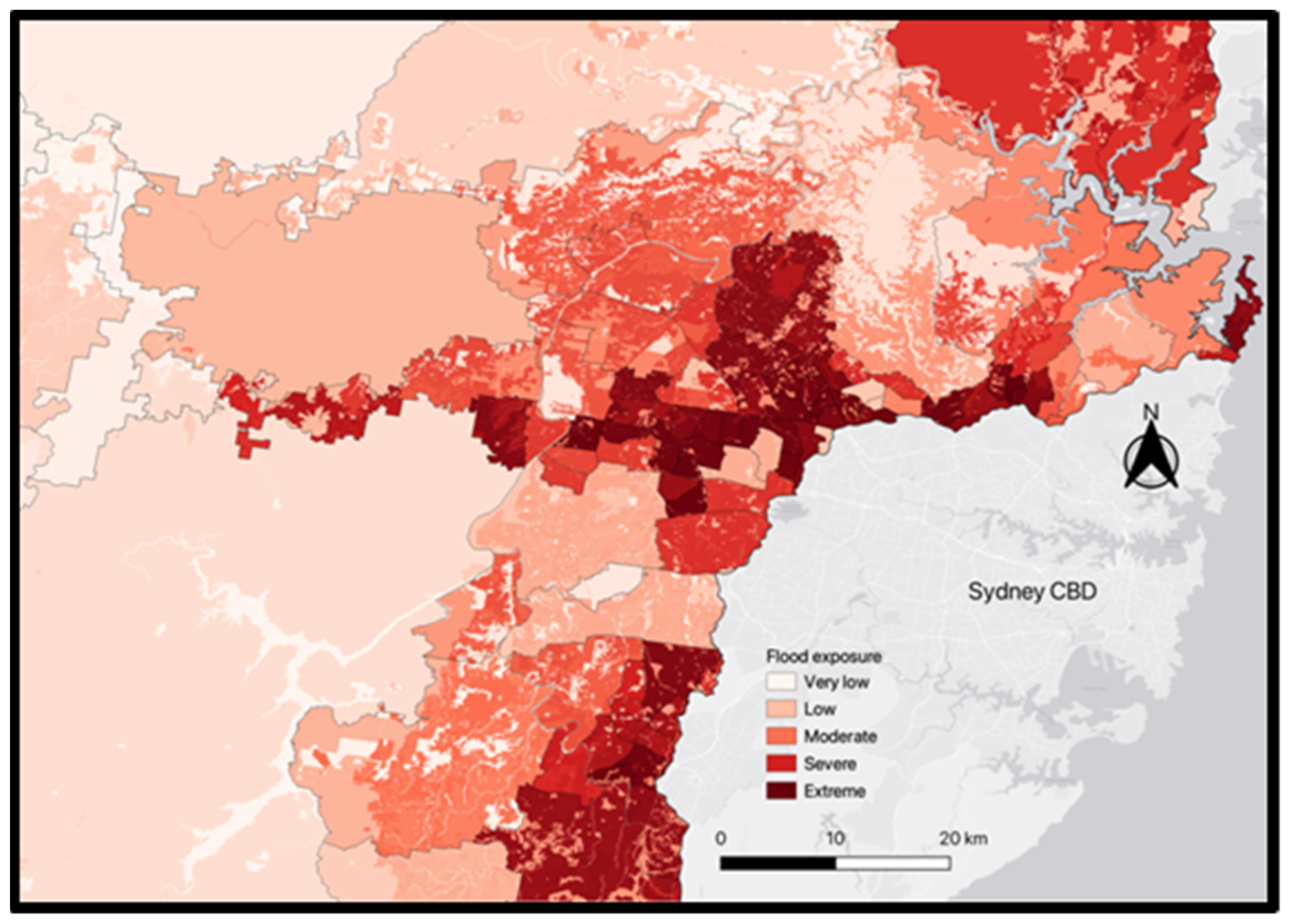
References
- Australian Bureau of Meteorology (BoM). Understanding Floods; Australian Government Bureau of Meteorology: Melbourne, Australia, 2022. Available online: http://www.bom.gov.au/australia/flood/knowledge-centre/understanding.shtml (accessed on 21 May 2022).
- FitzGerald, G.; Du, W.; Jamal, A.; Clark, M.; Hou, X.-Y. Flood Fatalities in Contemporary Australia (1997–2008). Emerg. Med. Australas. 2010, 22, 180–186. [Google Scholar] [CrossRef] [PubMed]
- Bates, P.D.; Quinn, N.; Sampson, C.; Smith, A.; Wing, O.; Sosa, J.; Savage, J.; Olcese, G.; Neal, J.; Schumann, G.; et al. Combined Modeling of US Fluvial, Pluvial, and Coastal Flood Hazard Under Current and Future Climates. Water Resour. Res. 2021, 57, e2020WR028673. [Google Scholar] [CrossRef]
- Pittock, B.; Abbs, D.; Suppiah, R.; Jones, R. Climatic Background to Past and Future Floods in Australia. In Advances in Ecological Research; Floods in an Arid Continent; Academic Press: Cambridge, MA, USA, 2006; Volume 39, pp. 13–39. [Google Scholar] [CrossRef]
- Intergovernmental Panel on Climate Change (IPCC). Summary for policymakers. In Climate Change 2022: Impacts, Adaptation and Vulnerability. Contribution of Working Group II to the Sixth Assessment Report of the Intergovernmental Panel on Climate Change; Cambridge University Press: Cambridge, UK, 2022. [Google Scholar]
- UN Expert Group. Natural Disasters and Vulnerability Analysis: Report of Expert Group Meeting, 9–12 July 1979; Office of the UN Disaster Relief Coordinator: Geneva, Switzerland, 1980. [Google Scholar]
- Crichton, D.; Ingleton, J. (Eds.) The Risk Triangle; Natural Disaster Management: London, UK, 1999; pp. 102–103. Available online: https://www.ilankelman.org/crichton/1999risktriangle.pdf (accessed on 12 May 2022).
- Australian Institute for Disaster Resilience (AIDR). Flood Hazard Guideline 7-3; Australian Institute for Disaster Resilience: Melbourne, Vic, Australia, 2017; Available online: https://knowledge.aidr.org.au/media/3518/adr-guideline-7-3.pdf (accessed on 12 May 2021).
- de Brito, M.M.; Evers, M. Multi-Criteria Decision-Making for Flood Risk Management: A Survey of the Current State of the Art. Nat. Hazards Earth Syst. Sci. 2016, 16, 1019–1033. [Google Scholar] [CrossRef]
- Espada Jr., R.; Apan, A.; McDougall, K. Understanding the January 2011 Queensland Flood: The Role of Geographic Interdependency in Flood Risk Assessment for Urban Community. In Proceedings of the Australian and New Zealand Disaster and Emergency Management Conference (ANZDMC 2013), Brisbane, Qld, Australia, 28–30 May 2013; AST Management Pty Ltd.: Gold Coast, Australia, 2013; pp. 68–88. [Google Scholar]
- Rashetnia, S.; Jahanbani, H. Flood Vulnerability Assessment Using a Fuzzy Rule-Based Index in Melbourne, Australia. Sustain. Water Resour. Manag. 2021, 7, 13. [Google Scholar] [CrossRef]
- Ologunorisa, T.; Abawua, M. Flood Risk Assessment: A Review. J. Appl. Sci. Environ. Manag. 2005, 9, 57–63. [Google Scholar] [CrossRef]
- Rafiei-Sardooi, E.; Azareh, A.; Choubin, B.; Mosavi, A.H.; Clague, J.J. Evaluating Urban Flood Risk Using Hybrid Method of TOPSIS and Machine Learning. Int. J. Disaster Risk Reduct. 2021, 66, 102614. [Google Scholar] [CrossRef]
- Kelly, M.; Kuleshov, Y. Flood Hazard Assessment and Mapping: A Case Study from Australia’s Hawkesbury-Nepean Catchment. Sensors 2022, 22, 6251. [Google Scholar] [CrossRef]
- Schwarz, I.; Kuleshov, Y. 2022: Flood Vulnerability Assessment and Mapping: A Case Study for Australia’s Hawkesbury-Nepean Catchment. Remote Sens. 2022, 14, 4894. [Google Scholar] [CrossRef]
- Infrastructure NSW. Hawkesbury-Nepean Valley Flood Risk Management Strategy. 2017. Available online: https://www.infrastructure.nsw.gov.au/media/1534/insw_hnvfloodstrategy__1_v2.pdf (accessed on 14 May 2022).
- Australian Government Infrastructure Australia. Hawkesbury-Nepean Valley Flood Management. 2022. Available online: https://www.infrastructureaustralia.gov.au/map/hawkesbury-nepean-valley-flood-management (accessed on 14 May 2022).
- Cremen, G.; Galasso, C.; McCloskey, J. Modelling and Quantifying Tomorrow’s Risks from Natural Hazards. Sci. Total Environ. 2022, 817, 152552. [Google Scholar] [CrossRef]
- Ming, X.; Liang, Q.; Dawson, R.; Xia, X.; Hou, J. A Quantitative Multi-Hazard Risk Assessment Framework for Compound Flooding Considering Hazard Inter-Dependencies and Interactions. J. Hydrol. 2022, 607, 127477. [Google Scholar] [CrossRef]
- Junger, L.; Hohensinner, S.; Schroll, K.; Wagner, K.; Seher, W. Land Use in Flood-Prone Areas and Its Significance for Flood Risk Management—A Case Study of Alpine Regions in Austria. Land 2022, 11, 392. [Google Scholar] [CrossRef]
- Ahmed, A.; Hewa, G.; Alrajhi, A. Flood Susceptibility Mapping Using a Geomorphometric Approach in South Australian Basins. Nat. Hazards 2021, 106, 629–653. [Google Scholar] [CrossRef]
- Membele, G.M.; Naidu, M.; Mutanga, O. Examining Flood Vulnerability Mapping Approaches in Developing Countries: A Scoping Review. Int. J. Disaster Risk Reduct. 2022, 69, 102766. [Google Scholar] [CrossRef]
- Papathoma-Köhle, M.; Schlögl, M.; Dosser, L.; Roesch, F.; Borga, M.; Erlicher, M.; Keiler, M.; Fuchs, S. Physical Vulnerability to Dynamic Flooding: Vulnerability Curves and Vulnerability Indices. J. Hydrol. 2022, 607, 127501. [Google Scholar] [CrossRef]
- Pant, R.; Thacker, S.; Hall, J.; Alderson, D.; Barr, S. Critical Infrastructure Impact Assessment Due to Flood Exposure. J. Flood Risk Manag. 2018, 11, 22–23. [Google Scholar] [CrossRef]
- NSW Government. NSW Critical Infrastructure Resilience Strategy. 2018. Available online: https://www.opengov.nsw.gov.au/publications/19460;jsessionid=8A7CF4082E06B2D165B02408F82BE1A3 (accessed on 14 May 2022).
- Australian Bureau of Statistics (ABS). Statistical Area Level 2. 2021. Available online: https://www.abs.gov.au/statistics/standards/australian-statistical-geography-standard-asgs-edition-3/jul2021-jun2026/main-structure-and-greater-capital-city-statistical-areas/statistical-area-level-2#:~:text=Statistical%20Areas%20Level%202%20(SA2s,Australia%20without%20gaps%20or%20overlaps (accessed on 14 May 2022).
- NSW Government. State of the Catchments 2010: Hawkesbury-Nepean Region; Department of Environment, Climate Change and Water: Sydney, NSW, Australia, 2010. [Google Scholar]
- Doganay, E.; Magaziner, J. Flash Flooding and Green Stormwater Infrastructure in Philadelphia: Areas for Further Improvement. Turk. J. Water Sci. Manag. 2017, 1, 18. [Google Scholar] [CrossRef]
- Hagos, Y.G.; Andualem, T.G.; Yibeltal, M.; Mengie, M.A. Flood Hazard Assessment and Mapping Using GIS Integrated with Multi-Criteria Decision Analysis in Upper Awash River Basin, Ethiopia. Appl. Water Sci. 2022, 12, 148. [Google Scholar] [CrossRef]
- Aitkenhead, I.; Kuleshov, Y.; Watkins, A.B.; Bhardwaj, J.; Asghari, A. Assessing Agricultural Drought Management Strategies in the Northern Murray–Darling Basin. Nat. Hazards 2021, 109, 1425–1455. [Google Scholar] [CrossRef]
- James, A.; Rowley, S.; Davies, A.; Ong, R.; Singh, R. Population Growth and Mobility in Australia: Implications for Housing and Urban Development Policies; Report; Australian Housing and Urban Research Institute: Melbourne, VIC, Australia, 2021. [Google Scholar]
- Northern Beaches Council. Visit Northern Beaches Council. 2022. Available online: https://www.northernbeaches.nsw.gov.au/things-to-do/visit (accessed on 15 May 2022).
- Tomar, P.; Singh, S.K.; Kanga, S.; Meraj, G.; Kranjčić, N.; Đurin, B.; Pattanaik, A. GIS-Based Urban Flood Risk Assessment and Management—A Case Study of Delhi National Capital Territory (NCT), India. Sustainability 2021, 13, 12850. [Google Scholar] [CrossRef]
- Feng, B.; Zhang, Y.; Bourke, R. Urbanization Impacts on Flood Risks Based on Urban Growth Data and Coupled Flood Models. Nat. Hazards 2021, 106, 613–627. [Google Scholar] [CrossRef]
- Amadio, M.; Mysiak, J.; Marzi, S. Mapping Socioeconomic Exposure for Flood Risk Assessment in Italy. Risk Anal. 2019, 39, 829–845. [Google Scholar] [CrossRef]
- Maheshwari, B.; Plunkett, M.; Singh, P. Farmers’ Perceptions about Irrigation Scheduling in the Hawkesbury-Nepean Catchment; Sydney, NSW, Australia. 2003. Available online: http://www.regional.org.au/au/apen/2003/refereed/113maheshwari.htm (accessed on 14 May 2022).
- United Nations International Strategy for Disaster Reduction Secretariat (UNISDR). National Disaster Risk Assessment, Hazard Specific Risk Assessment; United Nations Office for Disaster Risk Reduction: Geneva, Switzerland, 2017. [Google Scholar]
- Vakhshoori, V.; Zare, M. Is the ROC Curve a Reliable Tool to Compare the Validity of Landslide Susceptibility Maps? Geomat. Nat. Hazards Risk 2018, 9, 249–266. [Google Scholar] [CrossRef]
- Ahmed, N.; Hoque, M.A.-A.; Howlader, N.; Pradhan, B. Flood Risk Assessment: Role of Mitigation Capacity in Spatial Flood Risk Mapping. Geocarto Int. 2021, 1–23. [Google Scholar] [CrossRef]
- Schumann, G.; Bates, P.D.; Horritt, M.S.; Matgen, P.; Pappenberger, F. Progress in Integration of Remote Sensing–Derived Flood Extent and Stage Data and Hydraulic Models. Rev. Geophys. 2009, 47, 1–20. [Google Scholar] [CrossRef]
- D’Addabbo, A.; Refice, A.; Pasquariello, G.; Lovergine, F.P.; Capolongo, D.; Manfreda, S. A Bayesian Network for Flood Detection Combining SAR Imagery and Ancillary Data. IEEE Trans. Geosci. Remote Sens. 2016, 54, 3612–3625. [Google Scholar] [CrossRef]
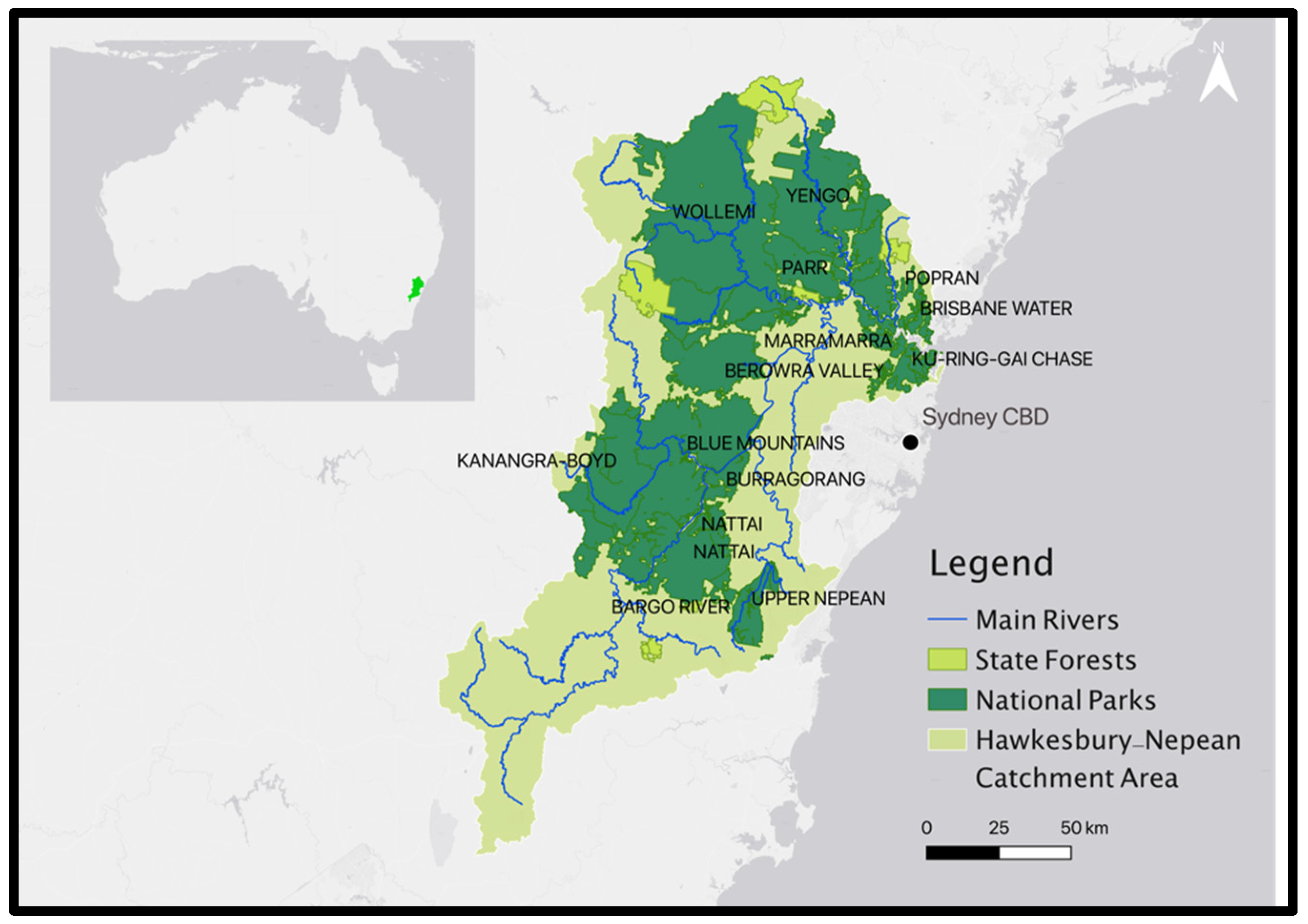

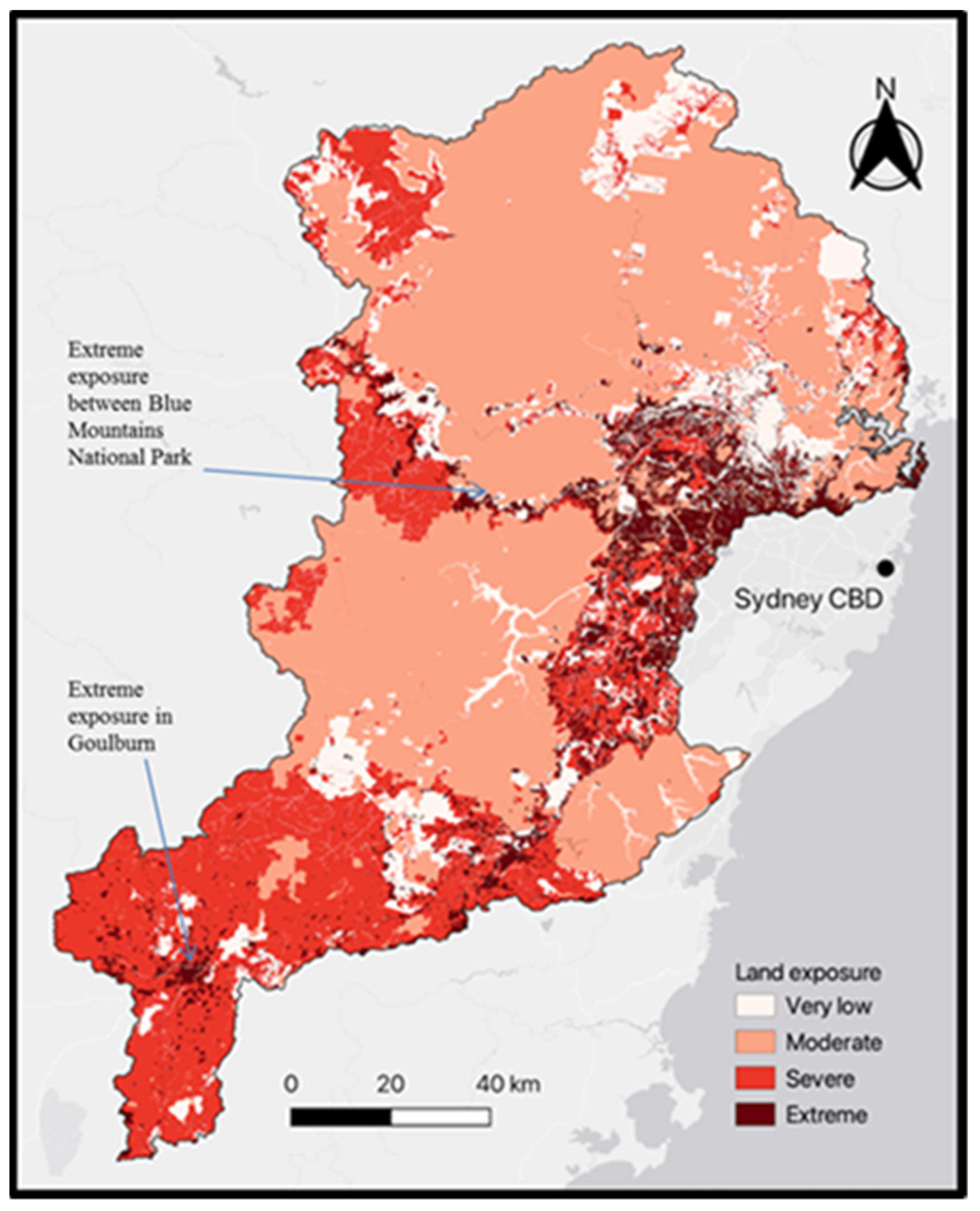
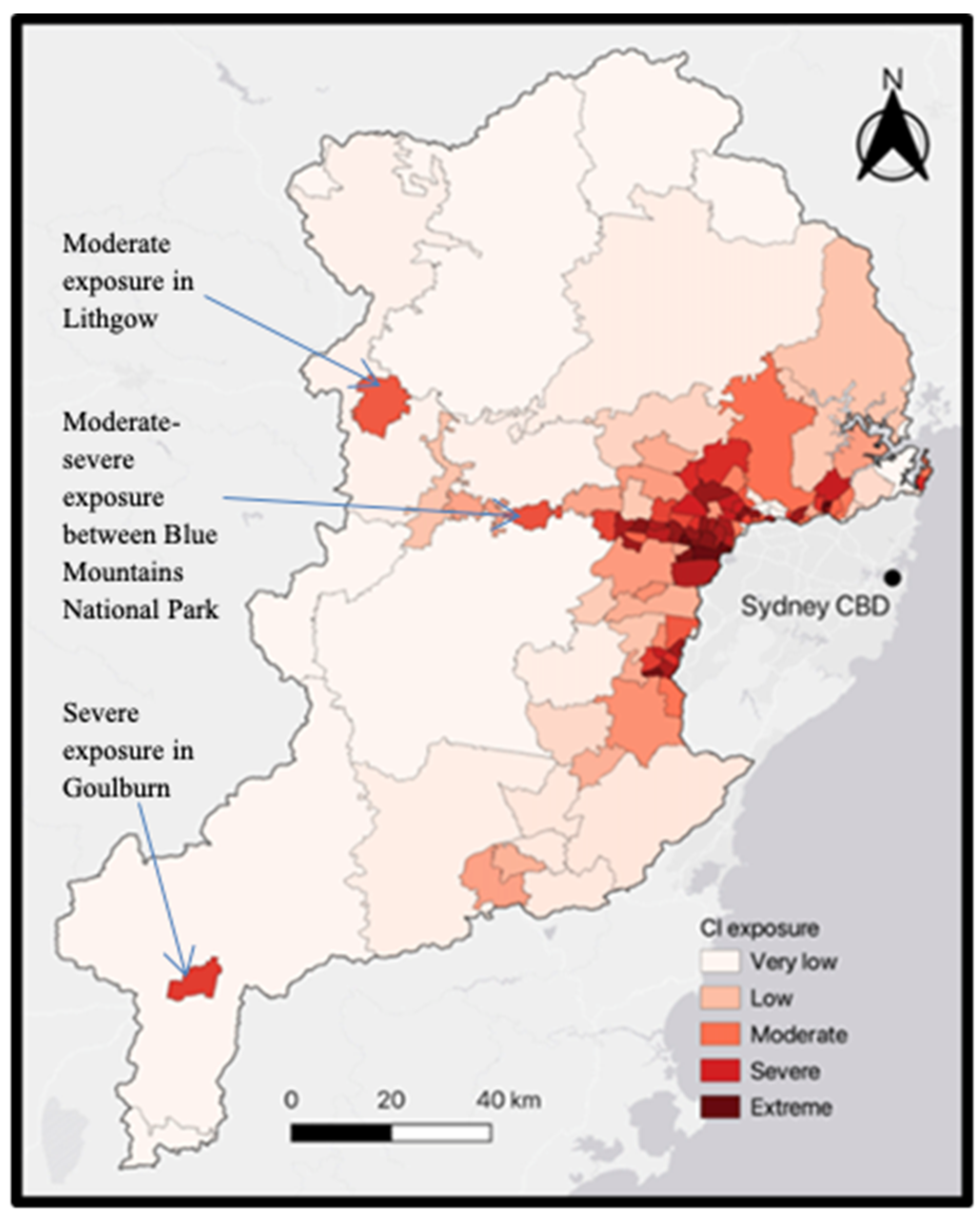
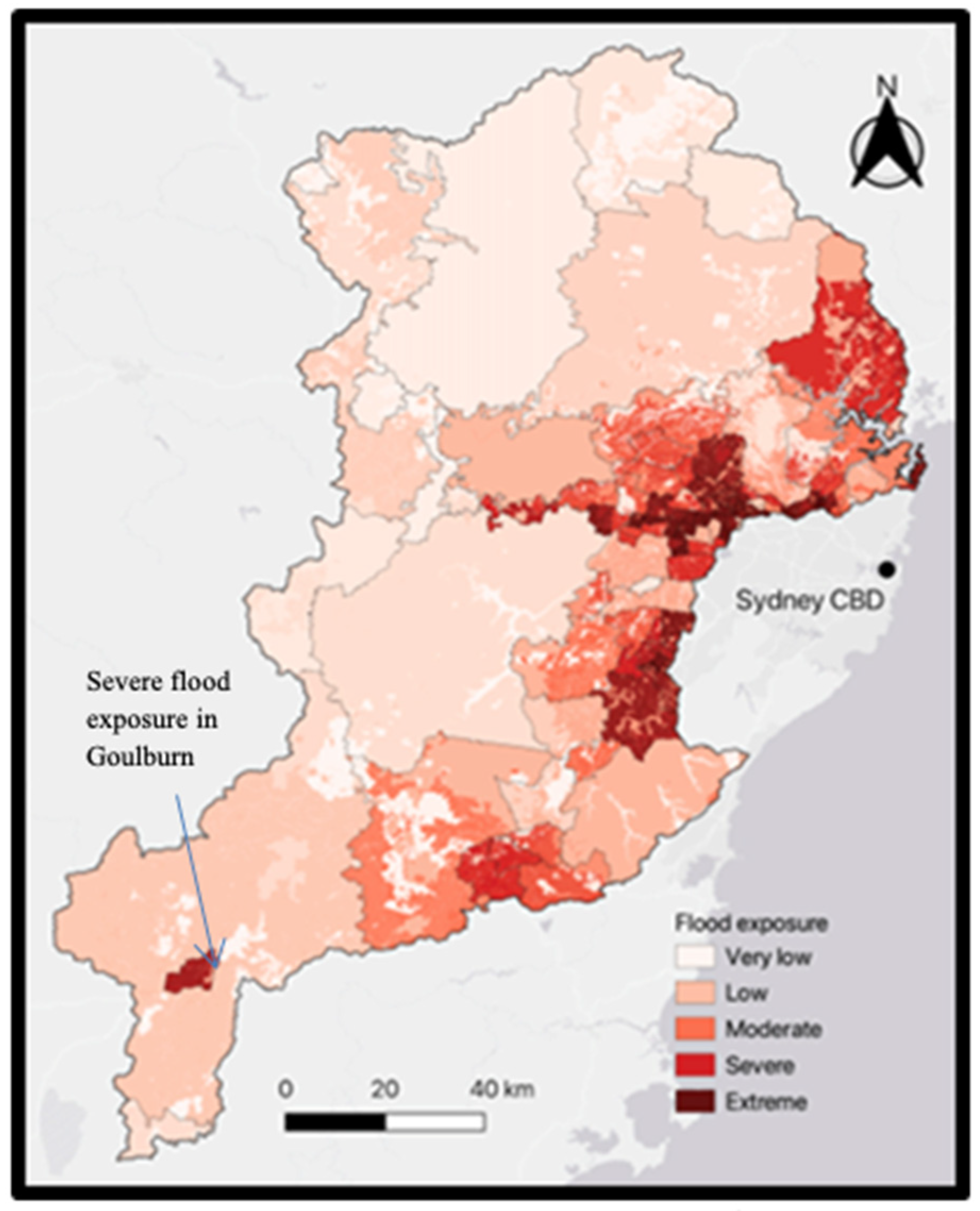
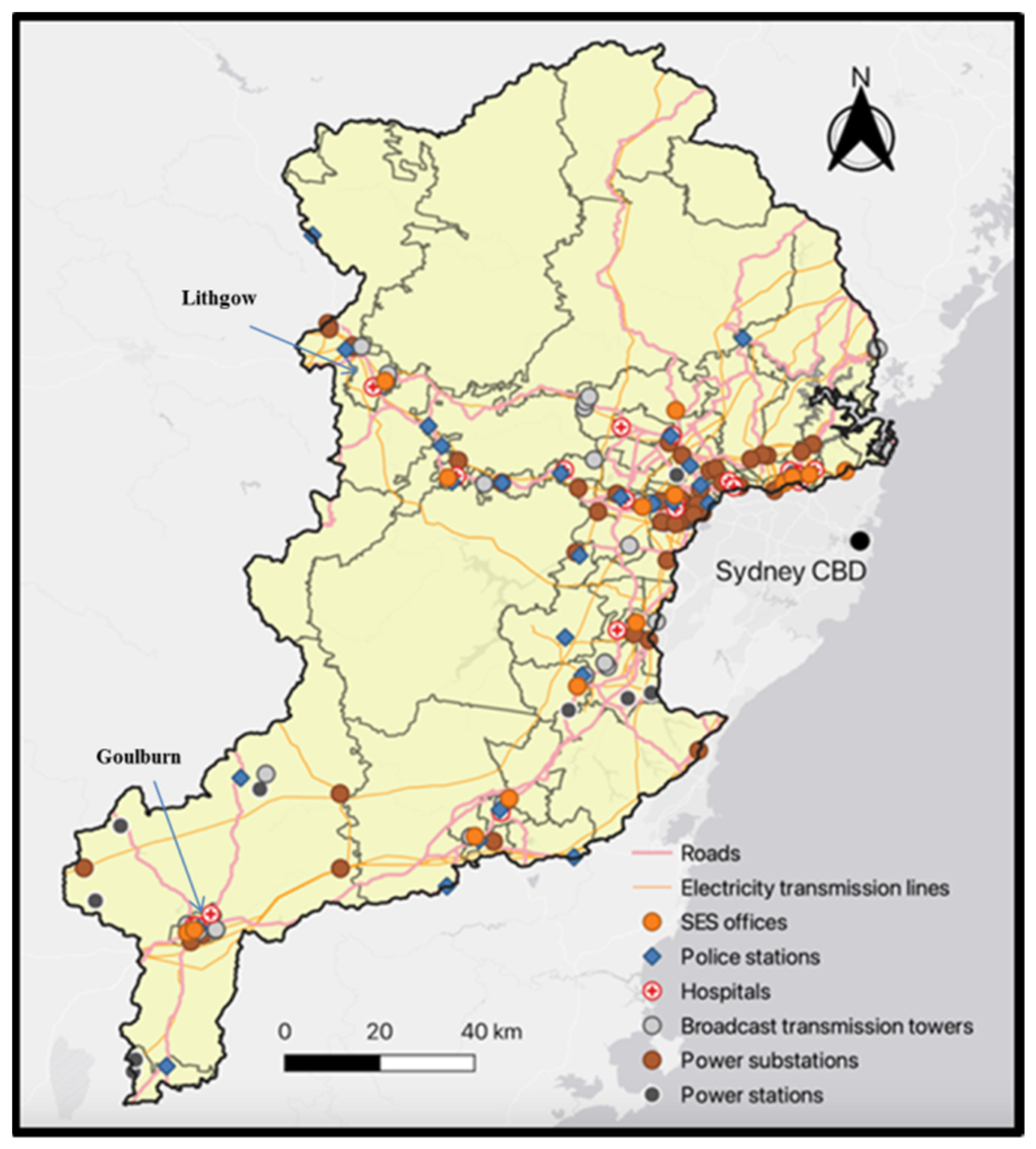
| Classification | Value (Weight Assigned) | Rating |
|---|---|---|
| Other | 0.1 | Very low |
| Water bodies | 0.1 | Very low |
| Nature conservation | 0.5 | Moderate |
| Forestry | 0.5 | Moderate |
| Cropping | 0.7 | High |
| Grazing | 0.7 | High |
| Horticulture | 0.7 | High |
| Infrastructure | 0.9 | Very high |
| Risk Class | Population Exposure Values | Land Use Exposure Values | Critical Infrastructure Exposure Values | Flood Exposure Index Values |
|---|---|---|---|---|
| Very low | 0.001–0.247 | 0.0003 | 0.000–0.241 | 0.001–0.247 |
| Low | 0.248–0.494 | - | 0.242–0.483 | 0.248–0.494 |
| Moderate | 0.495–0.742 | 0.5000 | 0.484–0.725 | 0.495–0.742 |
| Severe | 0.743–0.989 | 0.8432 | 0.726–0.967 | 0.743–0.989 |
| Extreme | 0.990 | 0.9497 | 0.968 | 0.990 |
| SA2 | Flood Exposure Score (Mean) | Flood Exposure Risk Class |
|---|---|---|
| Wahroonga (West)—Waitara | 0.990 | Extreme |
| Acacia Gardens | 0.964 | Severe |
| Glendenning—Dean Park | 0.963 | Severe |
| Cambridge Park | 0.947 | Severe |
| Goulburn | 0.851 | Severe |
Publisher’s Note: MDPI stays neutral with regard to jurisdictional claims in published maps and institutional affiliations. |
© 2022 by the authors. Licensee MDPI, Basel, Switzerland. This article is an open access article distributed under the terms and conditions of the Creative Commons Attribution (CC BY) license (https://creativecommons.org/licenses/by/4.0/).
Share and Cite
Ziegelaar, M.; Kuleshov, Y. Flood Exposure Assessment and Mapping: A Case Study for Australia’s Hawkesbury-Nepean Catchment. Hydrology 2022, 9, 193. https://doi.org/10.3390/hydrology9110193
Ziegelaar M, Kuleshov Y. Flood Exposure Assessment and Mapping: A Case Study for Australia’s Hawkesbury-Nepean Catchment. Hydrology. 2022; 9(11):193. https://doi.org/10.3390/hydrology9110193
Chicago/Turabian StyleZiegelaar, Mark, and Yuriy Kuleshov. 2022. "Flood Exposure Assessment and Mapping: A Case Study for Australia’s Hawkesbury-Nepean Catchment" Hydrology 9, no. 11: 193. https://doi.org/10.3390/hydrology9110193
APA StyleZiegelaar, M., & Kuleshov, Y. (2022). Flood Exposure Assessment and Mapping: A Case Study for Australia’s Hawkesbury-Nepean Catchment. Hydrology, 9(11), 193. https://doi.org/10.3390/hydrology9110193





